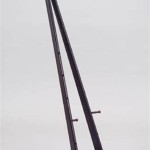Floor To Ceiling Kitchen Pantry: Maximizing Storage and Style
A floor to ceiling kitchen pantry represents a significant investment in both the functionality and aesthetic appeal of a kitchen space. Unlike smaller, prefabricated pantry solutions, a custom, floor to ceiling design optimizes every inch of available vertical space, providing ample storage for a wide range of kitchen necessities. This article will explore the benefits of floor to ceiling pantries, the design considerations involved, and the practical implementation of such a storage solution.
The increasing popularity of floor to ceiling pantries stems from a growing need for efficient organization and space utilization within the modern kitchen. As modern kitchens evolve into multi-functional spaces, seamlessly integrating cooking, dining, and even home office areas, the demand for organized storage solutions becomes paramount. A floor to ceiling pantry helps to conceal clutter, enhance the overall aesthetic, and ultimately improve the cooking experience.
The allure of a floor to ceiling pantry lies not only in its expansive storage capacity but also in its design flexibility. These pantries can be tailored to accommodate diverse storage needs, from dry goods and canned provisions to kitchen appliances and awkward-sized cookware. The ability to customize the internal layout, including adjustable shelving, pull-out drawers, and specialized organizers, ensures that every item has its designated place, contributing to a more streamlined and efficient kitchen workflow.
Beyond functionality, a well-designed floor to ceiling pantry can significantly enhance the visual appeal of a kitchen. Integrating the pantry seamlessly into the existing cabinetry and architectural style can create a cohesive and sophisticated look. The choice of materials, hardware, and finishes plays a crucial role in achieving a harmonious blend between the pantry and the overall kitchen design, contributing to a visually pleasing and inviting space.
Key Point 1: The Advantages of Vertical Space Utilization
One of the primary advantages of a floor to ceiling kitchen pantry is its efficient utilization of vertical space. Traditional storage solutions often leave significant empty space above cabinets and along walls, resulting in wasted potential and contributing to a cluttered appearance. A floor to ceiling pantry eliminates this wasted space by extending storage capacity all the way to the ceiling, maximizing the available area and creating a more organized and visually appealing kitchen.
By utilizing vertical space, a floor to ceiling pantry allows for the storage of a greater volume of items within the same footprint. This is particularly beneficial in smaller kitchens where every square inch of space is precious. The ability to store more items vertically frees up valuable countertop space, making food preparation and cooking more convenient and efficient. This also prevents the need for external storage solutions, contributing to a cleaner and less cluttered kitchen environment.
Furthermore, the vertical design of floor to ceiling pantries allows for the categorization and organization of items based on usage frequency. Items that are used infrequently, such as seasonal cookware or bulk purchases, can be stored on the upper shelves, while frequently used items are kept within easy reach on the lower shelves. This strategic arrangement enhances accessibility and streamlines the cooking process.
The height of a floor to ceiling pantry also provides an opportunity to incorporate specialized storage solutions, such as wine racks, spice organizers, and pull-out drawers for utensils and cookware. These specialized features optimize storage efficiency and contribute to a more organized and functional kitchen space. The flexibility of the design enables custom adjustments to cater to the specific needs and preferences of the homeowner, ensuring that the pantry perfectly aligns with their lifestyle.
Key Point 2: Design Considerations for Functionality and Aesthetics
Designing a floor to ceiling kitchen pantry requires careful consideration of both functionality and aesthetics. The design should prioritize ease of access, efficient organization, and seamless integration with the existing kitchen design. Several key factors influence the success of a floor to ceiling pantry design, including shelving configuration, door style, material selection, and hardware choices.
Shelf configuration is a crucial aspect of pantry design. Adjustable shelves are highly recommended, as they allow for customization to accommodate items of varying heights. Pull-out shelves or drawers can further enhance accessibility, particularly for items stored on lower shelves. The depth of the shelves should also be carefully considered, as overly deep shelves can lead to items getting lost or forgotten in the back. Optimizing shelf depth ensures that all items are easily visible and accessible.
The choice of door style can significantly impact the overall aesthetic of the pantry. Common options include hinged doors, sliding doors, and bi-fold doors. Hinged doors are the most traditional option, while sliding doors are a space-saving solution for narrow kitchens. Bi-fold doors offer a compromise between the two, providing easy access while minimizing the space required for door swing. The chosen door style should complement the overall design of the kitchen and reflect the homeowner's personal preferences.
Material selection plays a crucial role in both the durability and aesthetic appeal of the pantry. Solid wood is a classic choice that offers timeless beauty and exceptional durability. However, it can be a more expensive option. Alternatives such as plywood or MDF (medium-density fiberboard) provide a more budget-friendly solution while still maintaining a high level of quality and durability. The chosen materials should be resistant to moisture and warping, ensuring that the pantry can withstand the demands of a kitchen environment.
Hardware choices, such as knobs, pulls, and hinges, can also significantly impact the overall look and feel of the pantry. These elements should be chosen to complement the style of the cabinetry and the kitchen as a whole. A cohesive hardware selection can tie the entire design together and create a polished and sophisticated look. The functionality of the hardware should also be considered, ensuring that it provides a comfortable and reliable user experience.
Key Point 3: Practical Considerations for Implementation
The successful implementation of a floor to ceiling kitchen pantry requires careful planning and attention to detail. Several practical considerations must be addressed before, during, and after the installation process to ensure that the pantry meets the homeowner's needs and expectations. These considerations include space measurement, professional installation, lighting, and ongoing maintenance.
Accurate space measurement is essential for ensuring that the pantry fits perfectly within the designated area. Precise measurements of the height, width, and depth of the space are necessary to create a design that maximizes storage capacity without encroaching on other areas of the kitchen. Special attention should be paid to any architectural features, such as bulkheads, pipes, or electrical outlets, that may impact the design or installation process. Professional measurement services can help to ensure that the space is accurately assessed.
Professional installation is highly recommended for floor to ceiling pantries, particularly for custom-built designs. Experienced installers have the necessary skills and tools to ensure that the pantry is properly aligned, securely anchored, and seamlessly integrated with the surrounding cabinetry. A professional installation can also help to avoid potential problems, such as uneven floors, warped walls, or misaligned doors, that can compromise the functionality and appearance of the pantry. While DIY installation can save money, professional installation often results in a more durable, aesthetically pleasing, and problem-free outcome.
Adequate lighting is crucial for enhancing visibility and accessibility within the pantry. Incorporating interior lighting, such as LED strip lights or puck lights, can illuminate the shelves and make it easier to find and retrieve items. The lighting should be positioned to minimize shadows and provide even illumination throughout the pantry. Motion-activated lights can also be a convenient feature, automatically turning on and off as the door is opened and closed.
Ongoing maintenance is essential for preserving the beauty and functionality of a floor to ceiling pantry. Regular cleaning and organization can prevent clutter and ensure that all items remain easily accessible. Wiping down the shelves and doors with a damp cloth can remove dust and spills, keeping the pantry looking its best. Periodically checking the hinges and hardware and tightening any loose screws can prevent wear and tear and extend the lifespan of the pantry.
Ultimately, a floor to ceiling kitchen pantry is a functional and aesthetic addition to any kitchen. By carefully considering the design, practicality, and implementation, homeowners can create a storage solution that enhances both the efficiency and beauty of their culinary space.

Floor To Ceiling Pantry Cabinets Design Ideas

How To Use Floor Ceiling Kitchen Cabinets Their Full Potential

Floor To Ceiling Pantry Cabinets Design Ideas

How To Use Floor Ceiling Kitchen Cabinets Their Full Potential

Pantry Cabinet Ideas Smart Storage Solutions For An Organized Kitchen

6 Benefits Of A Floor To Ceiling Pantry

Built In Pantry Floor To Ceiling Cabinets Eastchester Ny

Pantry Cabinet Ideas Smart Storage Solutions For An Organized Kitchen

Floor To Ceiling Utility Cabinets Transitional Kitchen

Floor To Ceiling Kitchen Pantry Doors Design Ideas







